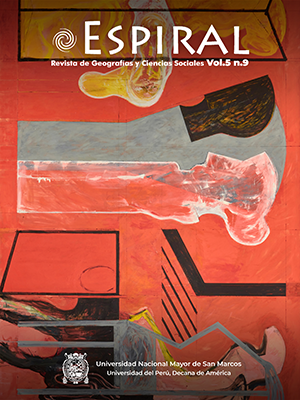Pedestrian environments evaluation around BRT stations
DOI:
https://doi.org/10.15381/espiral.v5i9.24671Keywords:
Pedestrian mobility, Built urban environment, Spatial análisisAbstract
Pedestrian mobility should be promoted as a local displacement option in every city, but this is not always the case. Typically, public administration allocates a large amount of resources to build massive public transportation system infrastructure that does not take into account pedestrian mobility. This research seeks to evaluate pedestrian mobility as a means of access to public transport, based on the built urban environment, from accessibility variables, safety, comfort, and attraction of displacements in stations and terminals of Corredor BRT Chimalhuacán–Nezahualcóyotl–Pantitlán. An analysis was realized of the surrounding streets of the 28 stations and two terminals of the Corredor BRT within a radius of 100 m. In the correlational study, quantitative spatial analysis thresholds were established to determine five levels of pedestrian quality, and thus classify built urban environments according to the level of pedestrian accessibility allow. The results indicate minimal pedestrian planning of built urban environments close to public transport, which generates conditions of insecurity in travel, vials accidents, public space abandonment, and urban image deterioration. This research identifies a need to consider the pedestrian approach zones in the design of this type of mass public transport since its consideration is strategic for the success of its operation.
Downloads
Published
Issue
Section
License
Copyright (c) 2023 Israel Gutiérrez-Alonso

This work is licensed under a Creative Commons Attribution 4.0 International License.
LOS AUTORES RETIENEN SUS DERECHOS:
a. Los autores retienen sus derechos de marca y patente, y también sobre cualquier proceso o procedimiento descrito en el artículo.
b. Los autores retienen el derecho de compartir, copiar, distribuir, ejecutar y comunicar públicamente el artículo publicado en la revista Espiral (por ejemplo, colocarlo en un repositorio institucional o publicarlo en un libro), con un reconocimiento de su publicación inicial en la revista Espiral.
c. Los autores retienen el derecho a hacer una posterior publicación de su trabajo, de utilizar el artículo o cualquier parte de aquel (por ejemplo: una compilación de sus trabajos, notas para conferencias, tesis, o para un libro), siempre que indiquen la fuente de publicación (autores del trabajo, revista, volumen, número y fecha).






